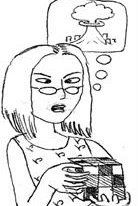So I set off on google to find out, and found this paper.
Granted, this might be totally wrong. I have an undergraduate degree in biology and I've forgotten most everything. So when the author of this paper goes off on microarrays, I only have a vague fuzzy memory of what he's on about. So feel free to flame me if you want. For those of you who don't want to read the paper, here's the real story of imaginal cells, or more properly, imaginal discs.
-Firstly, imaginal can mean "imagine", but in the context of bugs, it means "adult."
-When baby flies (maggots) come into this world, they have two types of cells. One type becomes their internal organs and muscles. The other type doesn't differentiate quite yet. They're all plain, vanilla generic cells. These are kind of freeloader cells while the fly is still a maggot.
-When the maggot starts to metamorphose into a fly, certain patches of imaginal cells, ie. near
 the wings and near the eyes start to divide, forming hollow disc-shaped structures. These are called imaginal disks. The ever-popular Pharyngula has a nice article on this with pictures of imaginal discs.
the wings and near the eyes start to divide, forming hollow disc-shaped structures. These are called imaginal disks. The ever-popular Pharyngula has a nice article on this with pictures of imaginal discs.-So how do these tumorous disks of plain cells know how to become fly eyes on flies, or catterpillar wings on a butterfly? How come the eye disks don't turn into wings? How come the leg disks don't turn into antennae? They're the same sort of plain vanilla cell, afterall.
-The paper above decides to find out. They have some poor grad student mutilate a dead maggot for various imaginal discs..the wing one, the atenna one, etc. They smash these up, then, they amplify the RNA transcripts in each one seperately. When you amplify mRNA with reverse transcription*, you wind up with a small strand of DNA called cDNA. That's why it's called "reverse transcription." Eventually, they have a bunch of cDNA transcripts from the wing disc, a bunch of cDNA from the eye disc, etc.
-Remember, that in basic genetics, the double stranded DNA seperates in places like a broken zipper, and RNA polymerase will slap base pairs onto the single strand. These are mRNA transcripts which then get sent off to the ribosomes so that they can get translated into proteins. The genome itself has several mechanisms by which it can block transcription or crank up production, winding up with a pile of mRNA or just a trickle being produced by different cells with the same genes. These are called transcription factors.
-The scientists then labeled all of these cDNA bits with a florescent element.
-These scientists then used a microarray to figure out exactly how much each gene was getting transcribed in each different imaginal disk.
-Microarrays are pretty damn neat in themselves. Think of a little chip that has millions of tiny little dots on it. Each dot is a bunch of pieces of the sequence from a different gene in the genome, which each have one end glued to the chip. You can get whole genomes for some organisms on a microarray.
-When you dump a bunch of pieces of flourescent cDNA on a microarray, they stick to their corresponding dot like iron filings to a magnet, and the more of them that stick, the brighter that spot glows when you stick it under a UV light. So, if your imaginal disk has a transcription factor that is bumping up production of gene A and gene B is getting transcribed normally, you'd expect the dot corresponding with A to glow bright green and B to glow a little.
What they found was that there was little difference in the numbers of transcripts for particular genes, on imaginal disks with the same type, ie. the left and right wing, but that there was a very big difference between the numbers of certain transcripts being produced on the wing disc vs the leg disc or the eye disc. Thus, the major difference between the pretty much identical patch of wing-disc cells and the eye-disc cells was the amount of each gene that was getting transcribed. Production of certain genes was slowed down in the wings and increased on the eyes and vice versa.
So, is a wing cell always destined to be a wing disc cell? Can you take a cell from a wing-disc and stick it on the maggot's face and end up with a fly that has a wing stuck to its face when the maggot pupates?
Well, actually, yeah.
This tells us two interesting things. Firstly, the part of the head outside the disk isn't doing anything to turn the antenna disk into antenna. Secondly, even though disks look pretty much the same on the pre-puation maggot, the cells in these areas must have already differentiated from each-other to the extent that their transcription factors can push them towards different ultimate fates.
So, in short, the imaginal cells of the caterpillar don't have any vibrations or harmonies. They also aren't any more of a prime example of creative synergy than any other cell in embryo development. In fact, if I were to pick a unique flower synergy cell, I'd choose the totipotent plant cell which can dedifferentiate and become a different kind of cell if it needs to. That's how you can grow a plant from half a leaf with a little auxin horomone slathered onto it and stuck unceremoniously in a new pot.
*I decided to spare you guys the picture of the guy sitting in a bathtub filled with maggots as an illustration for this. Come on, folks. It's not disgusting if you're doing it for charity! Wait. Yeah, it is. There are definitely parts of my body that I do not want maggots near, thank you. If you want to see some things that you just can't unsee, Google Image "maggots."
** The paper discussed here is
Expression profiling of Drosophila imaginal discs. Ansgar Klebes, Brian Biehs, Francisco Cifuentes and Thomas B Kornberg .Genome Biology 2002, 3:research0038.1-0038.16doi:10.1186/gb-2002-3-8-research0038
***Yes the fly in the picture has legs growing from its face. It's from a paper where they messed with the expression level of a gene called antp in the imaginal disc for the antenna and ended up growing a leg instead.


No comments:
Post a Comment